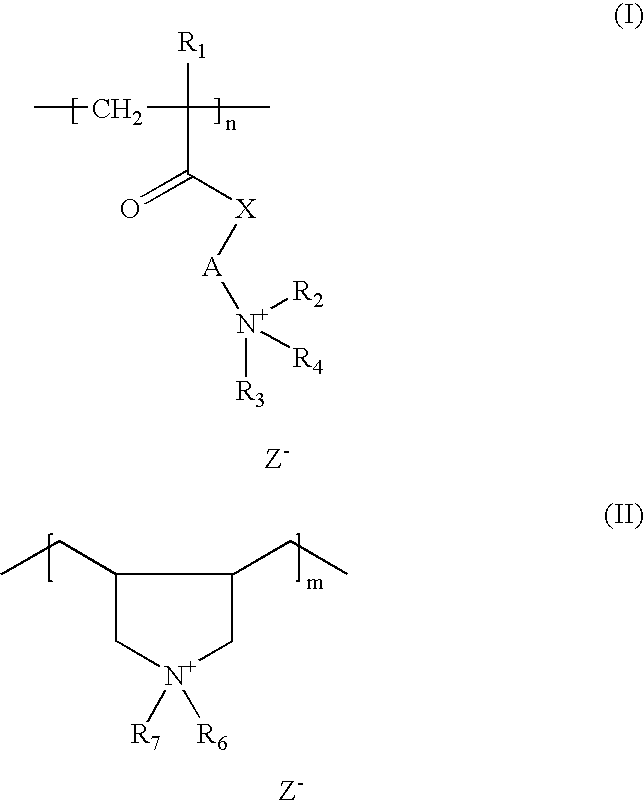Composition for improving wettability of surfaces
a technology of hydrophilicity and surface, applied in detergent compositions, detergent compounding agents, chemistry apparatus and processes, etc., can solve the problems of limited usefulness, difficult wetting with aqueous dye solutions, and difficult dyeing of these fibers or carpets, so as to improve the hydrophilicity and/or wettability of the treated substrate, improve the printability and dyeability, and increase the hydrophilicity of the treated substrate
- Summary
- Abstract
- Description
- Claims
- Application Information
AI Technical Summary
Benefits of technology
Problems solved by technology
Method used
Image
Examples
example 1
Synthesis of Block Polymer of Ethylene-co-Butylene and Methacryloyloxyethyl Trimethylammonium Chloride
[0160]Poly(ethylene-co-butylene) mono-ol (Aldrich, Mn˜3800.92 g) was dissolved in 300 mL tetrahydrofuran (THF) and is kept on molecular sieves for 24 h. A 3-neck flask equipped with a magnetic stirring bar and a dropping funnel is purged with nitrogen and charged with the THF solution. Pyridine (11 mL) is added. The dropping funnel is charged with 2-bromomethylpropionyl bromide (7.4 mL) and 50 mL dry THF. This mixture is added into the flask dropwise. The mixture is stirred at room temperature for 24 h. The mixture is filtered and precipitated with methanol. The product is rinsed with methanol and dried in vacuum. This macroinitiator is charged into a flask with 1.75 g copper(I) bromide. The flask is evacuated and refilled with nitrogen four times. 50 mL THF sparged with nitrogen for 1 h is added. After the macroinitiator is dissolved, pentamethyldiethylenetriamine (2.6 mL) sparged ...
example 2
Synthesis of Block Polymer of Ethylene-co-Butylene and Methacryloyloxyethyl Trimethylammonium Chloride
[0162]Poly(ethylene-co-butylene) mono-ol (Aldrich, Mn˜3800.83 g) is dissolved in 300 mL THF and kept on molecular sieves overnight. The solution is filtered into a 3-neck flask equipped with a magnetic stirring bar and a dropping funnel after it being purged with nitrogen. Pyridine (10 mL) is added. The dropping funnel is charged with 2-bromomethylpropionyl bromide (6.7 mL) and 67 mL dry THF. This mixture is added into the flask dropwise. The mixture is stirred at room temperature for 24 h. The mixture is filtered and precipitated with 400 mL methanol. The product is rinsed with methanol and dried in vacuum. 44.75 g of this macroinitiator is charged into a flask with 853 mg copper(I) bromide. The flask is evacuated and refilled with nitrogen four times. 25.3 mL THF sparged with nitrogen for 1 h is added. After the macroinitiator had dissolved, pentamethyldiethylenetriamine (1.26 mL)...
example 3
Block Copolymer of Lauryl Acrylate and Methacryloyloxyethyl Trimethylammonium Chloride
[0163]A mixture of 5.1 mL dimethylaminoethyl methacrylate, 52 mg cyanopropyl dithiobenzoate, 1.0 mL toluene and 3.8 mg azobis(isobutyronitrile) (AIBN) is sparged with N2 for 30 min, then heated at 70° C. for 51 h. The product is purified by precipitation with hexane and dried in vacuum. The product is dissolved in 1.0 mL toluene and 5.3 mL lauryl acrylate and 3.8 mg AIBN is added. The mixture is sparged with N2 for 1 h, then heated at 70° C. for 48 h. The product has a Mn of 25000. The product is dissolved in 30 mL methanol and transferred into a Shlenk tube. 2.73 g methyl chloride is condensed into the solution and the mixture is allowed to stand overnight. The product is precipitated with ethyl acetate and dried in vacuum.
PUM
| Property | Measurement | Unit |
|---|---|---|
| contact angle | aaaaa | aaaaa |
| contact angle | aaaaa | aaaaa |
| contact angle | aaaaa | aaaaa |
Abstract
Description
Claims
Application Information
 Login to View More
Login to View More - R&D
- Intellectual Property
- Life Sciences
- Materials
- Tech Scout
- Unparalleled Data Quality
- Higher Quality Content
- 60% Fewer Hallucinations
Browse by: Latest US Patents, China's latest patents, Technical Efficacy Thesaurus, Application Domain, Technology Topic, Popular Technical Reports.
© 2025 PatSnap. All rights reserved.Legal|Privacy policy|Modern Slavery Act Transparency Statement|Sitemap|About US| Contact US: help@patsnap.com



